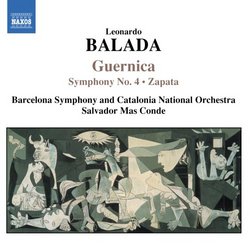| All Artists: Leonardo Balada, Salvador Mas, Barcelona Symphony Orchestra, National Orchestra of Catalonia Title: Leonardo Balada: Guernica; Symphony No. 4; Zapata Members Wishing: 0 Total Copies: 0 Label: Naxos Release Date: 8/17/2004 Genre: Classical Style: Symphonies Number of Discs: 1 SwapaCD Credits: 1 UPC: 747313234226 |
Search - Leonardo Balada, Salvador Mas, Barcelona Symphony Orchestra :: Leonardo Balada: Guernica; Symphony No. 4; Zapata
 | Leonardo Balada, Salvador Mas, Barcelona Symphony Orchestra Leonardo Balada: Guernica; Symphony No. 4; Zapata Genre: Classical
|
Larger Image |
CD Details |
CD ReviewsCaution: repeated listening to Track 8 will drive your neigh Russ | Richmond, VA | 08/13/2006 (4 out of 5 stars) "The style of Spanish composer Leodardo Balada (b. 1933) has undergone quite a transformation over the past several decades. Balada began his career as a serialist, but developed a more personal avant-garde technique, which was then transformed into a new style where varying degrees of folk dances are incorporated above dense and angular orchestral writing.
This release gives a good overview of this change with works ranging from 1966 through 1992. The first work on the disc, Guernica (1966), is from Balada's new avant-garde period where twelve-tone techniques were left behind. With that said, Guernica is still a difficult and modern piece of music. The music itself is symbolic of the bombing of a Basque town during the Spanish Civil War, which Balada experienced firsthand as a child. The music is a bit frightening and is reminiscent of compositions of Penderecki, who happens to be an exact contemporary of Balada. There are not too many musical landmarks in this composition, so I found myself a little lost in this work. The "Homage to Sarasate" and the "Homage to Casals" both from 1975, belong to Balada's most recent creative period where ethnic melodies are combined with avant-garde techniques. The "Homage to Sarasate" is quite extroverted and the incorporation of a traditional Spanish dance (the zapateado) is readily apparent. Conversely, the "Homage to Casals" is more reflective and the Catalan folk-melody that is incorporated within this piece is not always discernable. In the "Homage to Sarasate," one hears all of the characteristics that make Balada's recent style quite identifiable. First of all, there is a continuous "chugging" of the orchestra with endless eighth notes or triplets. Second, the music is very colorful, with solo strings and piecing multiple-part trumpet lines (sometimes muted) jumping out of the texture. Also, there are dissonant string glissandos (think Penderecki Symphony No. 1), that give the music a very modern feel. I find the concept of combining the "old with the new" is a fascinating one, but I am sure it won't appeal to everyone. Balada's single movement Symphony No. 4, incorporating Swiss elements (it was commissioned by a Swiss orchestra), begins slowly, but builds up steam as a relatively cheerful theme takes control. Again, make no mistake; this is a modern piece of music, and the traditional elements often overshadowed by Balada's spiky, dissonant writing. I enjoy the ending of this piece, but I find myself a little lost in the introduction and long central section of the symphony. The final piece on this program is the Zapata suite (composed in 1988), which incorporates Mexican folk motifs. This is probably the most accessible piece on this program. The second movement incorporates "La Cucaracha" while the finale makes use of "Jarabe Tapatio" (or the "Mexican Hat Dance" as it is known in the United States). To say that this finale (Track 8) is raucous is a bit of an understatement. I expect that you will either love this piece or want to jump out of the window when you hear it. I find myself in the former group, but then again, my tastes aren't exactly mainstream either. In conclusion, this disc can be highly recommended to Balada fans, as well as those looking to gain insight into the transformation of Balada's style. This is especially true when considering the excellent playing and clear sound present on the disc. As for the rest of us, the answer isn't so easy. I definitely prefer Balada's more recent compositions, especially the more extroverted ones. For that reason, I prefer the Naxos release containing Balada's Violin Concerto No.1 and the delightful "Sardana" composition, over the works on the present release. If you have already acquired that disc, and liked it, you should continue your discovery here. 69:25" |

 Track Listings (8) - Disc #1
Track Listings (8) - Disc #1